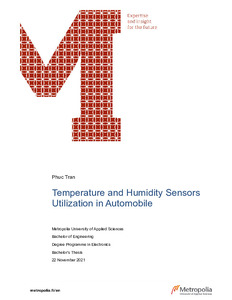Temperature and Humidity Sensors Utilization in Automobile
Tran, Phuc (2021)
Tran, Phuc
2021
All rights reserved. This publication is copyrighted. You may download, display and print it for Your own personal use. Commercial use is prohibited.
Julkaisun pysyvä osoite on
https://urn.fi/URN:NBN:fi:amk-2021112622027
https://urn.fi/URN:NBN:fi:amk-2021112622027
Tiivistelmä
The goal of the thesis work was to implement and utilize sensory elements to measure and send information about the environment inside a particular vehicle, thus letting the user know to prepare for the travel by defogging window and heating up the engine. The demonstration circuit will be able to measure a closed space temperature and humidity, then transferring the information to another platform via a Photon device so that it can be monitored from a distance.
The device includes one of each sensor type, which are a 1k-Ohm NTC thermistor used to react to difference in temperature and a Honeywell HIH-4000 series humidity sensor to measure the relative humidity of the environment. The outputs of these sensors will then be transferred to a Photon device capable of translating the value into approximate temperature and humidity values. In the end, these values are directed to a monitoring platform that can be viewed online.
The final test board achieves the goal of the project. Although the circuit is simple, the functionality can be increased by adding more elements to the circuit, as well as giving more options for environment settings and scheduling to the user.
The device includes one of each sensor type, which are a 1k-Ohm NTC thermistor used to react to difference in temperature and a Honeywell HIH-4000 series humidity sensor to measure the relative humidity of the environment. The outputs of these sensors will then be transferred to a Photon device capable of translating the value into approximate temperature and humidity values. In the end, these values are directed to a monitoring platform that can be viewed online.
The final test board achieves the goal of the project. Although the circuit is simple, the functionality can be increased by adding more elements to the circuit, as well as giving more options for environment settings and scheduling to the user.
